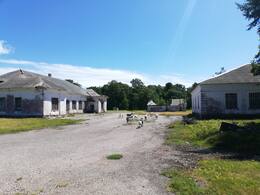Gyvenimo sąlygos Maantee
Maantee kaimo karinis dalinys buvo įsikūręs beveik pasaulio gale, net žiūrint iš Kuresarės.
Maantee dislokuotas karinis dalinys atrodė atskirtas nuo likusio pasaulio.
Sąlygos ten buvo labai prastos. Kariai buvo apgyvendinti prieškario kareivinėse, karininkai – kareivinėse su krosnies šildymu. Jie budėjo ištisas savaites, keisdami sargybą tarp bazių Piiri ir Kallemäe. Raketų kuras buvo toksiškas ir raketų valdymo kambaryje labai įkaisdavo. Radaras gaudavo signalus net iš 500 km.
Saarte Hääl 2015 10 31
Susijusios vietos
Mantės kaimo karinis miestelis
Ši karinė bazė Maantee kaime yra Saremos saloje, abipus senojo plento, už poros kilometrų nuo Servės karo muziejaus.
Kareivinių statyba čia prasidėjo 1940 m. balandžio mėn., pasirašius Savitarpio pagalbos paktą. Bazę pastatė vietos bendrovė „A. ja M. Edenberg“. Ją sudarė dvi kareivinės, kuriose tilpo 350 kareivių, valgykla, duonos fabrikas, pirtis, karininkų valgykla, klinika ir ledainė. Bazėje buvo dislokuoti 315-osios pakrantės gynybos baterijos būriai. Esami ūkiniai pastatai buvo nugriauti, kad būtų galima pastatyti naujus pastatus, todėl daugelis buvo priversti persikelti. Po karo čia buvo dislokuoti būriai, aptarnaujantys netoliese esančias pakrantės gynybos baterijas. Kareivinės vėl buvo pradėtos naudoti Šaltojo karo metu, šį kartą raketų kariuomenės. 1960 m. liepos mėn. čia atvyko 74907-oji divizija, ginkluota S-75 raketomis. Jie pradėjo statyti „Granit“ raketų sandėlį netoli kareivinių. Kitose kareivinėse buvo įsikūrusi viena radiotechnikos įmonė. 1972 m. „Granit“ sandėlyje buvo saugomos trys oro gynybos raketos su branduolinėmis galvutėmis. Raketų dalinys buvo išformuotas 1991 m. sausio mėn. Radiotechnikos kuopa kitais metais paliko Maantee kaimą.
Šiandien pastatai yra tokie apgriuvę, kad kelia pavojų. Raketų depo metalinės durys buvo pašalintos. Nepaisant to, kompleksas išlieka populiaria turistų lankoma vieta, nors lankytojai turi būti atsargūs dėl galimų pavojų.





